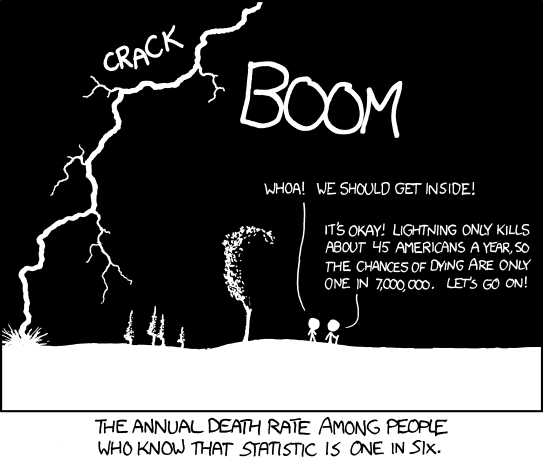 |
| Image from xkcd.com |
This is going to be a less-fluffy-than-normal bit of fluff, but today I am introducing my new statistics page on my blog. If you look up near the title of the blog you'll see two new tabs. Home takes you to where you can see my blog posts as before. Statistics take you to the new page.
A big part of the reason I started this blog was because I think it's important that every day people understand what researchers are up to. I think this is important for many reasons. Our tax dollars support a lot of this work, we should understand what we're buying. This work has the potential to help us better understand ourselves and the world around us--that's what gets scientists out of bed in the morning--and that knowledge shouldn't be locked away in an ivory tower. And, of course, sometimes the media picks up stories about new research and mangles them. This is bad for everyone: the researchers are made to look silly, and the public is misinformed. Knowledge is power. Power to the people. That sort of thing.
In my efforts to share the work researchers have done I end up talking a lot about statistics. Statistically significant differences. Statistically non-significant differences. Hazard ratios. P-values. Confidence intervals. These are all really important to understanding the research, and they aren't ideas everyone is familiar with. I've tried to explain them as they come up, but I've realized that as this blog grows that's going to become impractical. The same statistical concepts will come up again and again. If I explain them every time, I'm going to bore regular readers and those who show up with math skillz. If I only explain them the first time they come up, new readers or visitors only interested in one post could end up very lost. I've decided the solution is to collect all the information I think you'll need to know to have a basic understanding of the statistics I present in one place and just link over to it as needed in new posts. I'm not going to explain hardly anything about how statistics are generated, it's almost always done by a computer now. This is going to be about how to interpret statistics.
Let me give you an example from Monday. The NY Times said,
"These 17,000 children we found amounts to one child every hour being exposed to one of these laundry pod products,” said Dr. Marcel J. Casavant, a study author and the medical director of the poison center at Nationwide Children’s Hospital in Columbus, Ohio. “That’s a very different order of magnitude than other hazards.”That sounds like a lot of kids! At that rate it's only a matter of time before your kid is next in line...or is it? I took apart the number in Monday's post and if you remember I found that 0.003% of all kids under 6 or 0.03% of all kids under 6 living in a home with laundry pods in 2012 were poisoned by a laundry pod. When you put the statistics that way, it sounds like practically no kids at all. And that the odds are clearly in your kid's favor. And as for being a different magnitude of hazard? Also true, your kid is almost 10 times more likely to be injured by a car! But the quote rather implies the opposite, doesn't it? We all have heard there are three types of lies: lies, damned lies, and statistics. Numbers like I just showed you spell it out pretty plainly just how true that can be...unless you know your statistics too!
No comments:
Post a Comment